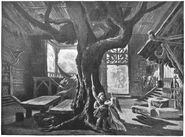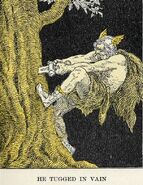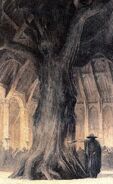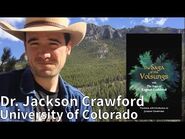Barnstokkr (Old Norse for "Offspring-trunk") is a big oak tree which stood in the centre of the hall of King Vǫlsungr in the Vǫlsunga saga. During a banquet, a strange one-eyed old man (who is later revealed as Óðinn himself) enters the hall and thrusts the sword into the tree. The sword was only be able to pulled by Prince Sigmundr and is later be named as "Gramr", the notable weapon which is also wielded by his son Sigurðr throughout the saga. Scholarly theories have been put forth about the implications of Barnstokkr and its relation to other trees in Germanic paganism.
Story
Barnstokkr makes its first mention in the chapter 2 of the Vǫlsunga saga where where King Vǫlsungr is described as having "let build a noble hall in such a wise, that a big oak-tree stood therein, and that the limbs of the tree blossomed fair out over the roof of the hall, while below stood the trunk within it, and the said trunk did men call Branstock."
In chapter 3, King Vǫlsungr is holding a marriage feast for his daughter Signý and King Siggeir at King Vǫlsungr's hall. At the hall, large fires are kindled in long hearths running the length of the hall, while in the middle of the hall stands the great tree Barnstokkr. That evening, while those attending the feast are sitting by the flaming hearths, they are visited by a one-eyed, very tall man whom they do not recognize. The stranger is wearing a hooded, mottled cape, linen breeches tied around his legs, and is barefooted. Sword in hand, the man walks towards Barnstokkr and his hood hangs low over his head, grey with age. The man brandishes the sword and thrusts it into the trunk of the tree, and the blade sinks to its hilt. Words of welcome fail the crowd.
The tall stranger says that he who draws the sword from the trunk shall receive it as a gift, and he who is able to pull free the sword shall never carry a better sword than it. The old man leaves the hall, and nobody knows who he was, or where he went. Everyone stands, trying their hand at pulling free the sword from the trunk of Barnstokkr. The noblest attempt to pull free the sword first followed by those ranked after them. Sigmundr, son of King Vǫlsungr, takes his turn, and—as if the sword had lain loose for him—he draws it from the trunk. The saga then continues.
Theories
Hilda Ellis Davidson draws links to the sword placed in Barnstokkr to marriage oaths performed with a sword in pre-Christian Germanic societies, noting a potential connection between the carrying of the sword by a young man before the bride at a wedding as a phallic symbol, indicating an association with fertility. Davidson cites records of wedding ceremonies and games in rural districts in Sweden involving trees or "stocks" as late as the 17th century, and cites a custom in Norway "surviving into recent times" for "the bridegroom to plunge his sword into the roof beam, to test the 'luck' of the marriage by the depth of the scar he made".
Davidson points out a potential connection between the descriptor apaldr (Old Norse "apple tree") and the birth of King Vǫlsungr, which is described earlier in the Völsunga saga as having occurred after Vǫlsungr's father Rerir sits atop a burial mound and prays for a son, after which the goddess Frigg has an apple sent to Rerir. Rerir shares the apple with his wife, resulting in his wife's long pregnancy. Davidson states that this mound is presumably the family burial mound, and proposes a link between the tree, fruit, mound, and the birth of a child.
Davidson opines that Siggeir's anger at his inability to gain the sword that Óðinn has plunged into Barnstokkr at first sight appears excessive, and states that there may be an underlying reason for Siggeir's passionate desire for the sword. Davidson notes that the gift of the sword was made at a wedding feast, and states that Barnstokkr likely represents the 'guardian tree', "such as those that used to stand beside many a house in Sweden and Denmark, and which was associated with the 'luck' of the family", and that the 'guardian tree' also had a connection with the birth of children. Davidson cites Jan de Vries in that the name barnstokkr "used in this story was the name given to the trunk of such a tree because it used to be invoked and even clasped by the women of the family at the time of childbirth."
Providing examples of historical structures built around trees, or with 'guardian trees' around or in the structure in Germanic areas, Davidson states that the "'luck' of a family must largely depend on the successful bearing and rearing of sons, and there is a general belief that when a guardian tree is destroyed, the family will die out." In connection with this, Davidson theorizes that at the bridal feast, it should have been Siggeir, the bridegroom, who drew the sword from the tree, "and that its possession would symbolize the 'luck' which would come to him with his bride, and the successful continuation of his own line in the sons to be born of the marriage". The sword having been refused to him, Davidson theorizes that this may well have been intended as a deadly insult, and that this lends a tragic air to the scene in the hall.
Jesse Byock states that the name Barnstokkr may not conceivably be the original name of the tree, and instead that it is possible that it may have originally been bran(d)stokkr, the first part of the compound potentially having been brandr (meaning brand or firebrand), a word sometimes synonymous with "hearth", and pointing to a potential connection to the fire burning within the hall. Byock notes that the tree is called an eik (Old Norse "oak"), which has an unclear meaning as the Icelanders often employed the word as a general word for "tree", and the tree is also referred to as apaldr, which is also a general term for trees. Byock theorizes that the latter reference to an apple tree may imply a further symbolic meaning pointing to the apple tree of the goddess Iðunn, and that the Barnstokkr may be further identified with the world tree Yggdrasill.
Andy Orchard states that the role and placement of Barnstokkr as a "mighty tree, supporting and sprouting through the roof of Vǫlsungr's hall" has clear parallels in Norse mythology with the world tree Yggdrasill, particularly in relation to Yggdrasill's position to the hall of Valhǫll. Orchard further points out parallels between Sigmundr's ability to solely remove the sword from the trunk and King Arthur's drawing of the sword Excalibur.
Gallery
Videos
See also
- Glasir
- Læraðr
- Sacred tree at Uppsala
References
- Byock, Jesse L. (Trans.) (1990). The Saga of the Volsungs: The Norse Epic of Sigurd the Dragon Slayer. University of California Press. ISBN 0-520-23285-2
- Clark, George. Timmons, Daniel (2000). J.R.R. Tolkien and His Literary Resonances. Greenwood Publishing Group. ISBN 0-313-30845-4
- Davidson, H. R. (1960). "The Sword at the Wedding" as collected in Folklore, Vol. 71, No. 1 (March 1960).
- Köhler, Joachim. Spencer, Stewart (2004). Richard Wagner: The Last of the Titans. Yale University Press. ISBN 0-300-10422-7
- Flieger, Verlyn (2005). Interrupted Music: The Making of Tolkien's Mythology. Kent State University Press. ISBN 0-87338-824-0
- Orchard, Andy (1997). Dictionary of Norse Myth and Legend. Cassell. ISBN 0-304-34520-2











